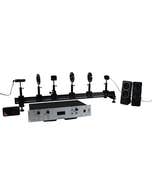Pockels effect assembly
Birefringence induced by an electric field: use the Pockels effect to encode and transport information on an optical carrier.
Topics covered:
- Polarization and change in the state of light polarization
- Natural birefringence and birefringence induced by an electric field
- Polarization modulation, amplitude modulation
- Electro-optic modulator, Lithium Niobate crystal (LiNbO3), Pockels effect
- Half-wave voltage (Vp), measurement of the electro-optic coefficient by different methods
- Optical transmission in free space, demodulation
Principles and objectives:
A laser beam is linearly polarized at 45° to the axes (X,Y) of the Lithium Niobate crystal. The beam passes through this crystal along its optical axis (Z).
An applied voltage to the modulator allows for a linear modification of one of the refractive indices of the LiNbO3 crystal (Pockels effect). The natural birefringence of the material is then modified, resulting in a phase shift between the ordinary and extraordinary waves propagating in the crystal. This phase shift induces a change in polarization at the ouExperimentut of the modulator. The analyzer placed before the detector transforms this polarization variation into intensity variation.
The transfer function of the setup (transmitted intensity / incident intensity) is experimentally measured either by rotating the analyzer or by applying a continuous voltage to the crystal.
The resulting curve is used to study its operating points or to determine the half-wave voltage and the electro-optic coefficient (r22) of the material.
This product was developed in collaboration with the LMOPS laboratory in Metz.
Composition:
▪ 1 electro-optic modulator (Pockels cell, LiNbO3 crystal) with 2 SMA-SMA cables
▪ 1 control generator-amplifier for Pockels cell
▪ 1 amplified detector with adjustable gain
▪ 1 experiments manual
| Thématique TP | Optique, Polarisation, Effet Pockels, Composants optiques actifs |
| Type de matériel | Ensemble à compléter |








